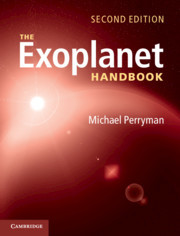Description
The Exoplanet Handbook (2nd Ed., Revised edition)
Author: Perryman Michael
A complete and in-depth review of exoplanet research, covering the discovery methods, physics and theoretical background.
Language: English
Subject for The Exoplanet Handbook:
Approximative price 90.27 €
In Print (Delivery period: 14 days).
Add to cart
Publication date: 08-2018
952 p. · 19.3x25.3 cm · Hardback
952 p. · 19.3x25.3 cm · Hardback
Description
/li>Contents
/li>Biography
/li>
With the discovery of planets beyond our solar system 25 years ago, exoplanet research has expanded dramatically, with new state-of-the-art ground-based and space-based missions dedicated to their discovery and characterisation. With more than 3,500 exoplanets now known, the complexity of the discovery techniques, observations and physical characterisation have grown exponentially. This Handbook ties all these avenues of research together across a broad range of exoplanet science. Planet formation, exoplanet interiors and atmospheres, and habitability are discussed, providing in-depth coverage of our knowledge to date. Comprehensively updated from the first edition, it includes instrumental and observational developments, in-depth treatment of the new Kepler mission results and hot Jupiter atmospheric studies, and major updates on models of exoplanet formation. With extensive references to the research literature and appendices covering all individual exoplanet discoveries, it is a valuable reference to this exciting field for both incoming and established researchers.
Preface; 1. Introduction; 2. Radial velocities; 3. Astrometry; 4. Timing; 5. Microlensing; 6. Transits; 7. Imaging; 8. Host stars; 9. Brown dwarfs and free-floating planets; 10. Formation and evolution; 11. Interiors and atmospheres; 12. The Solar System; Appendix A. Numerical quantities; Appendix B. Notation and acronyms; Appendix C. Radial velocity exoplanets; Appendix D. Transiting exoplanets; Appendix E. Lensing exoplanets; Appendix F. Imaging exoplanets; References; Subject index; Object index.
Michael Perryman had a thirty-year career with the European Space Agency (ESA), initially as the scientific leader of the Hipparcos astrometry mission, 1981–97, and also serving as project manager for its operational phase, 1989–93. With Lennart Lindegren, he was the co-originator of the Gaia astrometry mission, a project expected to make important contributions to exoplanet science in the coming years. He was ESA's project scientist for Gaia from its earliest concepts in 1995 until the Critical Design Review in 2008, establishing the payload concept, technical feasibility, operational and data analysis principles, and its organisational structure, and coordinating its scientific case. He was Professor of Astronomy at Rijksuniversiteit Leiden, The Netherlands between 1993 and 2009, and Bohdan Paczyński Visiting Professor at Princeton University, New Jersey in 2013.
© 2024 LAVOISIER S.A.S.

